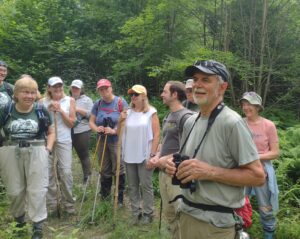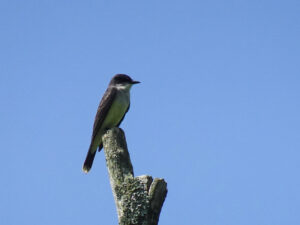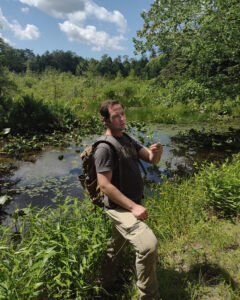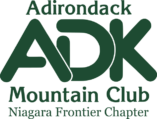It was a perfect July day- 80 degrees, low humidity and bright blue sky to explore a floating fen. Several staff of the WNY Land Conservancy led ADK members on a 2.5 mile tour of the private property that the organization is raising funds to purchase.  The land includes a floating poor fen, a beaver pond, and forest. Naturalist Erik Danielson provided a wealth of information as we hiked. Fens develop when glaciers retreat and create a kettle depression lined with nonporous soil where water collects. Water acidity results in the differences between calcium poor and calcium rich fens which leads to different types of plants flourishing in these habitats. The thickness of the floating peat layers on top of the water also contributes to the variety. We were fortunate to see carnivorous sundew plants which feed on trapped insects, yellow spatterdock water lilies, cinnamon ferns, and various sedges. After leaving the 8 acre floating fen we continued through a hardwood forest until we reached a large pond created by busy beavers. We listened to the calls of the Eastern Kingbird
The land includes a floating poor fen, a beaver pond, and forest. Naturalist Erik Danielson provided a wealth of information as we hiked. Fens develop when glaciers retreat and create a kettle depression lined with nonporous soil where water collects. Water acidity results in the differences between calcium poor and calcium rich fens which leads to different types of plants flourishing in these habitats. The thickness of the floating peat layers on top of the water also contributes to the variety. We were fortunate to see carnivorous sundew plants which feed on trapped insects, yellow spatterdock water lilies, cinnamon ferns, and various sedges. After leaving the 8 acre floating fen we continued through a hardwood forest until we reached a large pond created by busy beavers. We listened to the calls of the Eastern Kingbird  and watched as they swooped above the water to catch insects. Blue Dasher dragonflies
and watched as they swooped above the water to catch insects. Blue Dasher dragonflies![]()
![]() darted along the Great Bur-reed covered shoreline and Monarch butterflies flitted amongst the Swamp Milkweed blossoms.
darted along the Great Bur-reed covered shoreline and Monarch butterflies flitted amongst the Swamp Milkweed blossoms.
It was easy to see why this special piece of land is so important ecologically. Kyle Semmel, communications manager, and Marisa Riggi, acting executive director, spoke passionately about the WNY Land Conservancy’s mission which includes purchasing this unique wetland and forest to prevent it from being logged and developed. They are half way to reaching the $925,000 goal to purchase and maintain the property that will include a trail for public access. For additional information follow this link Floating Fen | WNYLC. Also visit: The Field Guides Podcast for more information.
They are half way to reaching the $925,000 goal to purchase and maintain the property that will include a trail for public access. For additional information follow this link Floating Fen | WNYLC. Also visit: The Field Guides Podcast for more information.
– Lynn Rehfeld-Kenney
